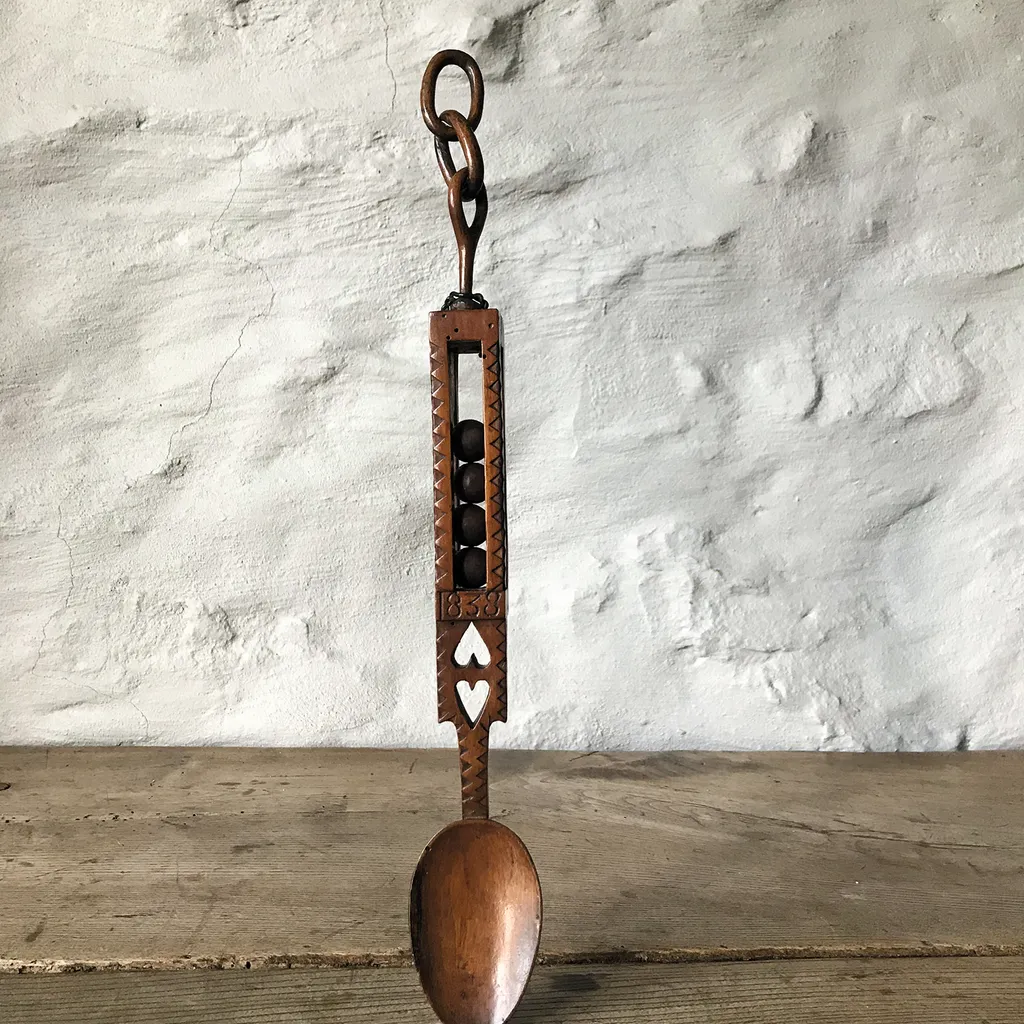What is the history of love spoons?
The history of love spoons is rather vague. ‘The earliest one discovered dates from the late 17th century and it’s on display at St Fagans,’ reveals expert dealer Tim Bowen. ‘As with lots of folk art, there are no written records, so it’s difficult to pinpoint exactly when they were first made.’

What do love spoons mean?
These days, antique and new spoons are often given as presents at weddings and christenings, but that’s a fairly recent tradition. Originally, they were like love letters from tongue-tied young men, the acceptance of which meant that courting could begin.
‘They were mostly carved from sycamore by men and given to their desired sweethearts as gifts to woo them,’ explains Tim. ‘You often find spoons with women’s names carved in them.’
In modern times, when new mass-produced ‘love spoon’ souvenirs are sold online and in gift shops for just a few pounds, all sorts of specific meanings have become attributed to the carved symbols on love spoons. ‘A heart motif obviously means love,’ says Tim.
‘There are often anchors carved into spoons, which some people think means ‘anchored to you’, but it was actually the symbol of Christ – a cross.’ Locks and keys can be seen to represent setting up home or giving a lover the keys to one’s heart. Celtic knots signify eternal love, twisted stems mean togetherness. Other popular symbols include chalices, pinwheels and bells.
Tim thinks too much emphasis is sometimes put on interpreting the meaning of love spoon symbols. ‘I have a beautiful spoon in stock at the moment with four carved balls in a cage – it’s a very difficult thing to achieve as they’re not placed in, they’re all carved from the same single piece of wood.
Some people say the number of balls indicates how many children the carver hoped to have, but I’ve seen spoons with 20 balls inside them! I don’t like to get in the way of a good story, but I think we often look at symbols in folk art through 21st-century eyes.’

How were love spoons originally made?
The romantic idea of a young man sitting by the fire in the evening whittling away to express his love is beguiling, but Tim doesn’t think all spoons were made this way.
‘Although I’m sure that sometimes happened, I have seen some spoons that were definitely made by the same hand. I would imagine that a canny craftsman might say: “Look, I’ll make you a spoon, Dai.” But that gets in the way of the narrative a little bit!’
The quality of love spoons varies dramatically. Some are intricate, demonstrating immense skill. ‘I saw one that featured tiny wheels and cogs,’ remembers Tim. ‘It was so delicate and weighed nothing in my hand. It’s incredible to think that each of these spoons was carved from a single piece of sycamore – they’re not assembled.’ Others are much less refined, but ‘primitive’ ones still fetch eye-watering amounts.
How to collect love spoons
Love spoons have been collected for a long time. Tim has a photo of a Victorian parlour with a whole wall covered in love spoons. ‘They’ve certainly been collected since the 19th century,’ he says. ‘They tend not to come on to the market often so that’s why they command such high prices.’
Tim has a beautiful one in stock dated 1838 for £2,450, but rarer spoons in good condition can fetch £7,000 or £8,000. ‘There are serious collectors out there, who have been gathering them for 20 years,’ reveals Tim. ‘It’s mind boggling when you see 60 love spoons together.’ Tim has four or five of his own at home. ‘We like the more humble ones.’

As with all valuable antiques, it’s important to buy from a reputable dealer. ‘There are fakes out there,’ warns Tim. ‘You have to be on your toes. I turn down more than I buy. Even the ones that were made in the 1920s or 1930s have acquired an aged patina now, so you have to use all your instincts and knowledge to spot the older ones.’
Love spoons are often slightly marked. ‘They’re usually hung on a wall beside the fire on a bit of ribbon and you often get damage where the spoon has fallen down and there’s a little nibble in the bowl where it hit the floor.’
Slight blemishes only add to their charm. Spoons are admired not only for their workmanship, but also their sentimental value. They were a labour of love, after all.
Books
Love Spoons by Elin Meek - Buy it now
Fine Art of Carving Lovespoons by David L. Western - Buy it now
Welsh Love Spoons by Annie Bullen - Buy it now
The Artful Wooden Spoon by Josh Vogel - Buy it now
Love Spoons by Ralph Hentall - Buy it now
